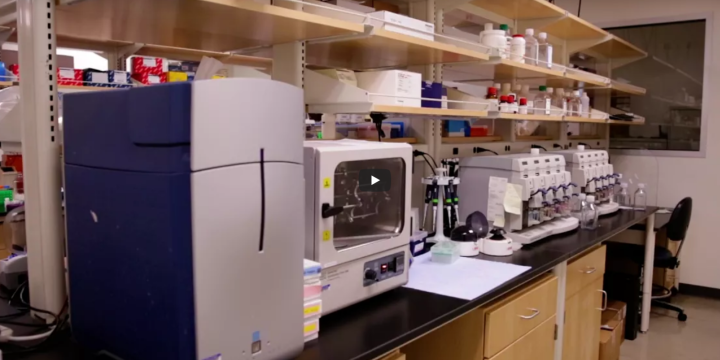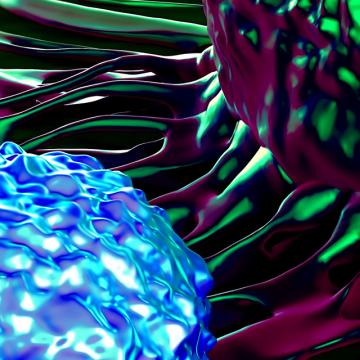Integrative Genomics And Bioinformatics
The Integrative Genomics Shared Resource (IG-SR) combines the expertise and instrumentation of two facilities—COH Integrative Genomics and Bioinformatics Core and TGen Collaborative Sequencing Center —to provide an integrated array of services for genomics and bioinformatics. The overall goal of the IG-SR is to provide comprehensive genomic and bioinformatics services to COHCCC Members. The IG-SR accomplishes this goal using state-of-the-art genome technologies and innovative analytical methods supported by a dedicated team of instrument operators and bioinformaticians. The SR is co-directed by Drs. Xiwei Wu (COH) and Jonathan Keats (TGen).
The IG-SR is equipped with major instrumentation for genomic analyses, including an Illumina NovaSeq 6000, NextSeq 2000, NextSeq 500, iSeq 100, 2 MiSeqs, a PacBio Sequel IIe, multiple 10X Genomics Chromium instruments, a Mission Bio Tapestri, and an Illumina iScan system. These instruments enable a wide range of genomic studies. These include: RNA analysis (transcriptome sequencing [ribosomal rRNA depletion], mRNA-seq, circRNA-seq, small RNA-seq [miRNA], full length isoform-seq); DNA analysis of whole genomes or targeted sequences (SNP/INDEL, structural variants, copy number); protein and DNA/RNA interaction (ChIP-seq and RIP-seq); DNA methylation (WGBS-seq, RRBS-seq, EPIC methylation array); genome-wide and custom genotyping (SNP arrays); and single cell genomics and transcriptomics (scRNA-seq, scDNA-seq, scVDJ-seq, scCITE-seq). An Eppendorf epMotion and an Agilent Bravo Automated Liquid Handling Platform are used for automated library preparation. IG-SR also has multiple ABI ViiA 7 Real-time PCR systems, for library quantification and expression validation, as well as multiple instruments for sample and library QC.
The IG-SR recently launched several new services, including multiOMICS single cell sequencing, spatial transcriptomics, and improved long read sequencing. The bioinformatics support has been expanded, allowing more efficient and in-depth data analysis support.
Specific Aims for IG-SR:
Aim 1. Provide cost-effective access to cutting-edge genomic technologies.
Aim 2. Facilitate the design and optimization of complex genomic projects.
Aim 3. Provide bioinformatics support for data generated by COHCCC Members and from public data sources.
Members Utilization by %Revenue 2017–21: 87.2 Total (29.6 MCBC, 10.4 DCT, 9.8 CI, 20.8 HM, 16.7 CCPS)
Publications by Members: 210, 69 with Impact Factor >10
Grants Supported: 177 Total (6 ACS, 6 CIRM, 9 DoD, 4 LLS, 79 NCI of 177 NIH (1 P01, 96 R01, 8 U01))
IGBC is a shared resource facility within the Beckman Research Institute (BRI) at City of Hope. Partially supported by an NO comprehensive cancer center grant, the goal of the IGC is to provide comprehensive genomic services from pre-experimental consultation, sample processing, data analysis and interpretation to manuscript and grant preparation. The IGC is committed to providing these services in a cost-effective and timely manner to support basic science, translational, and clinical researchers at City of Hope. The IGC is equipped with major instrumentation for genomic analyses, including an lllumina NovaSeq 6000, an lllumina NextSeq 2000, an lllumina NextSeq 500, an lllumina iSeq 100, two lllumina MiSeqs, a PacBio Sequel lie, multiple 10X Genomics Chromium instruments, a Mission Bio Tapestri, and an lllumina iScan system. These instruments enable a wide range of genomic capabilities. IGC also has multiple ABI ViiA 7 Real-time PCR systems, an excellent technology for library quantification and expression validation, as well as multiple instruments for sample and library QC (Nanodrop, Qubit, along with Agilent Bioanalyzers). These instruments enable a wide range of genetic, epigenetic and gene expression analysis capabilities, and complement each other for different applications. On a single cell level, RNA-seq and VDJ profiling can be done from the same cells using 10x Genomics' Chromium system, while DNA sequencing can be done using the Tapestri system. We also support the new Visium spatial gene expression platform from 1 Ox Genomics. With a highly experienced team of bioinformaticians integrated within the core, efficient genomic data analysis services will be provided to convert high throughput data into biologically interpretable results. The team has established analysis pipelines for all major sequencing applications, e.g. RNA-seq, single cell RNA-seq and DNAseq. single cell VDJ-seq, single cell ATAC-seq, TCR/BCR-seq, miRNA-seq, ChlP-seq, exome-seq, amplicon-seq, etc., a11ct has extensive expertise in utilizing both commercial and open-source software tools for sequencing data analysis. The core processes over 500 projects each year and supports bioinformatics analysis of all the data generated from these samples. The bioinformatics staff are also very experienced in mining public domain data, such as GEO, TCGA, and 1000 genome databases. The core also supports data sharing and depositing of the genomic data into NCBl's GEO, SRA, and dbGap database for data sharing.
IGBC scientists provide consultation services for experimental design, assay development, and generation of high-quality data. The IGBC Director, Xiwei Wu, has more than 20 years of experience performing complex genomics analyses and providing consultation services to investigators. The highly experienced IGBC team members perform core assays and optimize protocols for difficult to analyze samples. Sample integrity and data are held to the most rigorous quality control standards.
IGBC bioinformaticians provide analysis of a wide spectrum of genomics data generated within the IGBC, data from COHCCC investigators, and data originating from external sources. The team implements analysis pipelines using commercial and open-source tools and develops novel in-house algorithms as needed to provide COHCCC investigators with all necessary tools for analyzing genomic data sets.
Services include:
- Project consultation and experimental design
- Sample preparation and library construction
- lllumina short read sequencing
- Pacbio long read sequencing
- Sing I e cell genomics
- Microarray se1vices
- Sanger sequencing
- Bioinformatics data analysis
- Education and training
The typical turnaround time for microarray service is one to two weeks, three to four weeks for sequencing, and one to four weeks for data analysis. However, please note that the actual turnaround time might vary depending on the workload and complexity of the project.






Full bio (coming soon)
Shu Tao
Assistant Research Professor
Ching Ouyang
Assistant Research Professor
Lin Wang
Assistant Research Professor
Yuqi Zhao
Assistant Research Professor
Supriyo Bhattacharya
Assistant Research Professor
Haiqing Li
Staff Scientist
Hanjun Qin
Staff Scientist
Wei Chen
Staff Scientist
Min-Hsuan Chen
Staff Scientist
Hyejin Cho
Staff Scientist
Tae Hyuk Kang
Staff Scientist
Charles Warden
Bioinformatics Specialist
Rosalina Lonergan
RAII
Contact the Team
This single-cell genomics instrument can help study RNA and DNA on a single-cell level. It has been used for RNA-seq, VDJ-seq, ATAC-seq and more.
This instrument is used to provide quality control and quantification of DNA and RNA samples.
This instrument provide quantification of DNA or RNA samples up to 96 samples at a time.
The LE220 reproducibly shears DNA to desired lengths in a multi-sample parallel-processing mode.
This liquid handling instrument provides an automation solution for smaller-scale applications, such as beads purification and PCR assays.
This liquid handling instrument provides an automation solution for NGS library preparation, which can speed up the process and ensure better consistency of the results.
This microarray platform is used primarily for GWAS and DNA methylation applications. Many arrays with different throughputs are available.
This high throughput sequencer generates 20M to 25M reads with lengths up to 300bp.
This high throughput sequencer generates up to 12 billion reads in paired-end 1500bp.
This instrument is used to provide quality control and quantification of DNA and RNA samples.
This sequencer generates 4 million HiFi reads with average length up to 30-40kb. This can be used for small genome de novo assembly, microbiome profiling, RNA isoform sequencing, and other applications that need long reads.
In a given year, City of Hope conducts more than 400 clinical trials enrolling more than 6,000 patients.

Zhao, Z. M., Yost, S. E., Hutchinson, K. E., Li, S. M., Yuan, Y. C., Noorbakhsh, J., Liu, Z., Warden, C., Johnson, R. M., Wu, X., Chuang, J. H., & Yuan, Y.
Ding, Y. C., Steele, L., Warden, C., Wilczynski, S., Mortimer, J., Yuan, Y., & Neuhausen, S. L.
Slavin, T. P., Teh, J. B., Weitzel, J. N., Peng, K., Wong, F. L., Qin, H., Wang, J., Wu, X., Mei, M., Pillai, R., Wang, Y., Tsang, K. K., Pozhitkov, A., Krishnan, A., Forman, S. J., & Armenian, S. H.
Song, A., Dai, W., Jang, M. J., Medrano, L., Li, Z., Zhao, H., Shao, M., Tan, J., Li, A., Ning, T., Miller, M. M., Armstrong, B., Huss, J. M., Zhu, Y., Liu, Y., Gradinaru, V., Wu, X., Jiang, L., Scherer, P. E., & Wang, Q. A.
Yoon, S., Wu, X., Armstrong, B., Habib, N., & Rossi, J. J.
City of Hope is focused on basic and clinical research in cancer, diabetes and other life-threatening diseases.




